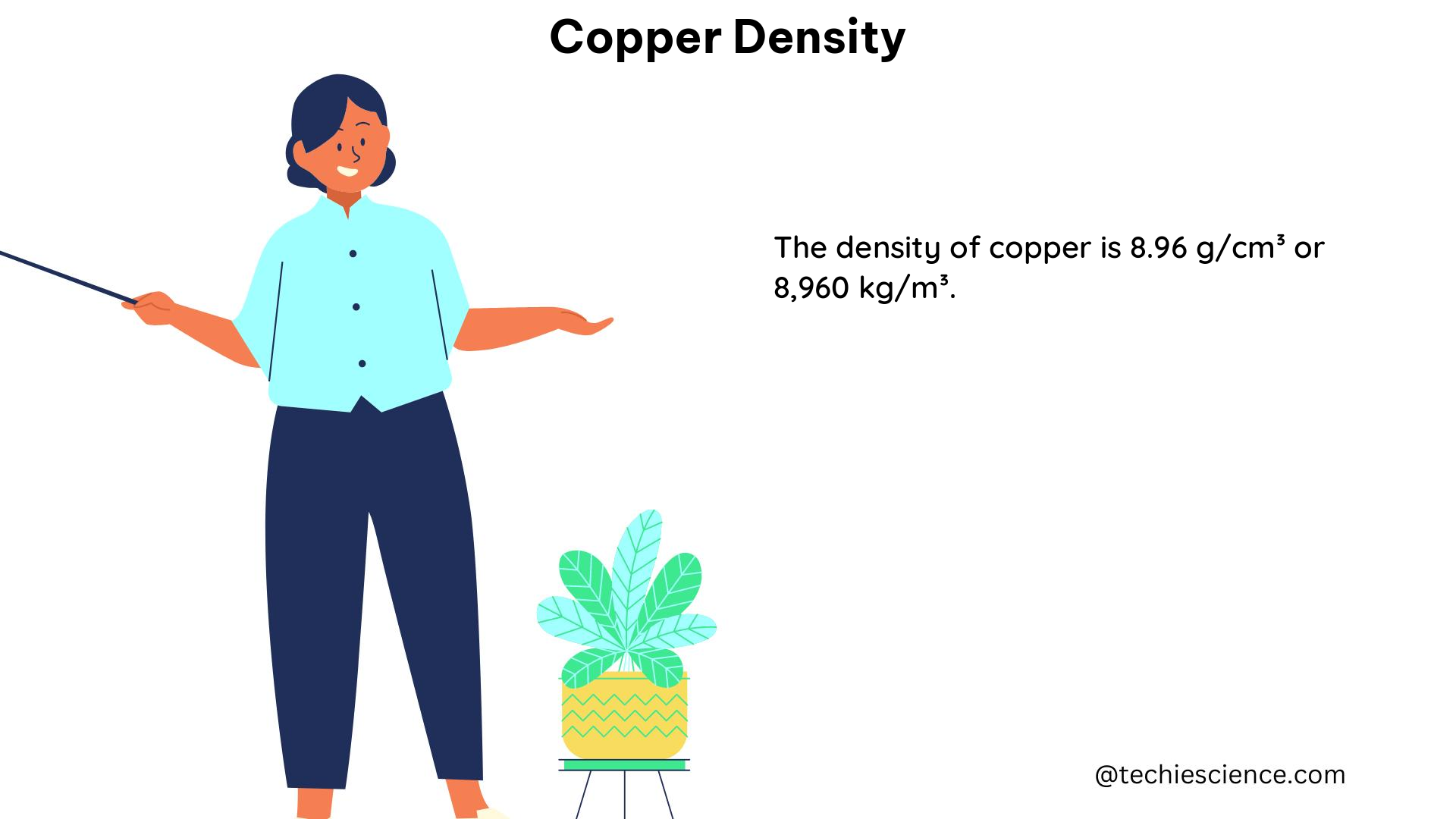Copper density is a critical property in various fields, including physics, materials science, and engineering. The density of copper, often denoted by the symbol ρ (rho), is the mass per unit volume of the metal. Its value is approximately 8.96 g/cm³ or 8960 kg/m³, representing the density at room temperature (20°C) in its solid state.
Understanding Copper Density Calculations
Calculating Copper Density
The density of copper can be calculated using the formula:
ρ = m/V
Where:
– ρ (rho) is the density of copper
– m is the mass of the copper sample
– V is the volume of the copper sample
The volume of the copper sample can be determined through various methods, such as:
- Water Displacement: Submerging the copper sample in water and measuring the volume of water displaced.
- Direct Measurement: Using calipers or a micrometer to measure the dimensions of a cylindrical or rectangular prism-shaped copper sample.
For example, to calculate the density of a 35.4 cm block of pure copper with a mass of 316 g, you would use the formula:
ρ = m/V = m/(l×w×h) = 316 g / (0.354 m × 0.01 m × 0.01 m) = 8960 kg/m³
Where:
– l is the length of the block (0.354 m)
– w is the width of the block (0.01 m)
– h is the height of the block (0.01 m)
Determining the Mass of Copper
The density of copper can also be used to determine the mass of a given volume of the metal. For instance, the mass of 1.00 cubic meter of copper is:
m = ρ × V = (8960 kg/m³) × (1 m³) = 8960 kg
Estimating the Average Distance between Copper Atoms
Copper density can be used to estimate the average distance between copper atoms in the solid state. Using the atomic weight of copper (63.55 g/mol) and the solid copper density (8.96 g/cm³), the average distance between copper atoms can be estimated as follows:
Average distance = (3 / (4π × ρ × N))^(1/3)
Where:
– N is Avogadro’s number (6.022 × 10^23 atoms/mol)
Calculating the Number of Copper Atoms in a Volume
The density of copper can also be used to estimate the number of atoms in a given volume of the metal. For example, the number of atoms in 1 cm³ of copper is:
N = ρ / (atomic weight) = (8.96 g/cm³) / (63.55 g/mol) × (6.022 × 10^23 atoms/mol) ≈ 8.49 × 10^22 atoms/cm³
Copper Alloy Density Calculations

Copper density is also crucial in understanding the properties of copper alloys, such as brass and bronze. The density of these alloys can be calculated based on the proportions of their constituent metals and their individual densities.
For example, to calculate the density of a brass alloy containing 75% copper and 25% zinc (density = 7.14 g/cm³), you would use the formula:
ρ_brass = 0.75 × ρ_Cu + 0.25 × ρ_Zn = 0.75 × (8.96 g/cm³) + 0.25 × (7.14 g/cm³) = 8.27 g/cm³
Factors Affecting Copper Density
The density of copper can be influenced by various factors, including:
- Temperature: Copper density decreases as temperature increases due to thermal expansion.
- Impurities: The presence of impurities in copper can affect its density.
- Crystalline Structure: The arrangement of copper atoms in the crystal structure can impact the overall density.
- Porosity: The presence of voids or pores in the copper sample can lower its measured density.
Practical Applications of Copper Density
Copper density has numerous practical applications, including:
- Material Selection: Knowing the density of copper is crucial for selecting the appropriate material for various engineering applications, such as heat sinks, electrical conductors, and structural components.
- Mass Estimation: The density of copper can be used to estimate the mass of a given volume of the metal, which is important for transportation, storage, and handling considerations.
- Alloy Design: Understanding the density of copper and its alloys is essential for designing and optimizing the properties of these materials for specific applications.
- Quality Control: Measuring the density of copper can be used as a quality control metric to ensure the consistency and purity of the material.
- Atomic Structure Analysis: Copper density can be used to estimate the average distance between copper atoms, which provides insights into the material’s atomic-scale structure and properties.
Conclusion
Copper density is a fundamental property that plays a crucial role in various fields, including physics, materials science, and engineering. By understanding the principles and applications of copper density, professionals in these domains can make informed decisions, optimize material performance, and advance their respective areas of study and practice.
References
- Copper Density – ScienceDirect
- Percent Error Calculation for Copper Density
- Accuracy and Precision of Copper Density Measurements
- Copper Density Calculation Example
- Calculating Copper Density for a Copper Bar

The lambdageeks.com Core SME Team is a group of experienced subject matter experts from diverse scientific and technical fields including Physics, Chemistry, Technology,Electronics & Electrical Engineering, Automotive, Mechanical Engineering. Our team collaborates to create high-quality, well-researched articles on a wide range of science and technology topics for the lambdageeks.com website.
All Our Senior SME are having more than 7 Years of experience in the respective fields . They are either Working Industry Professionals or assocaited With different Universities. Refer Our Authors Page to get to know About our Core SMEs.